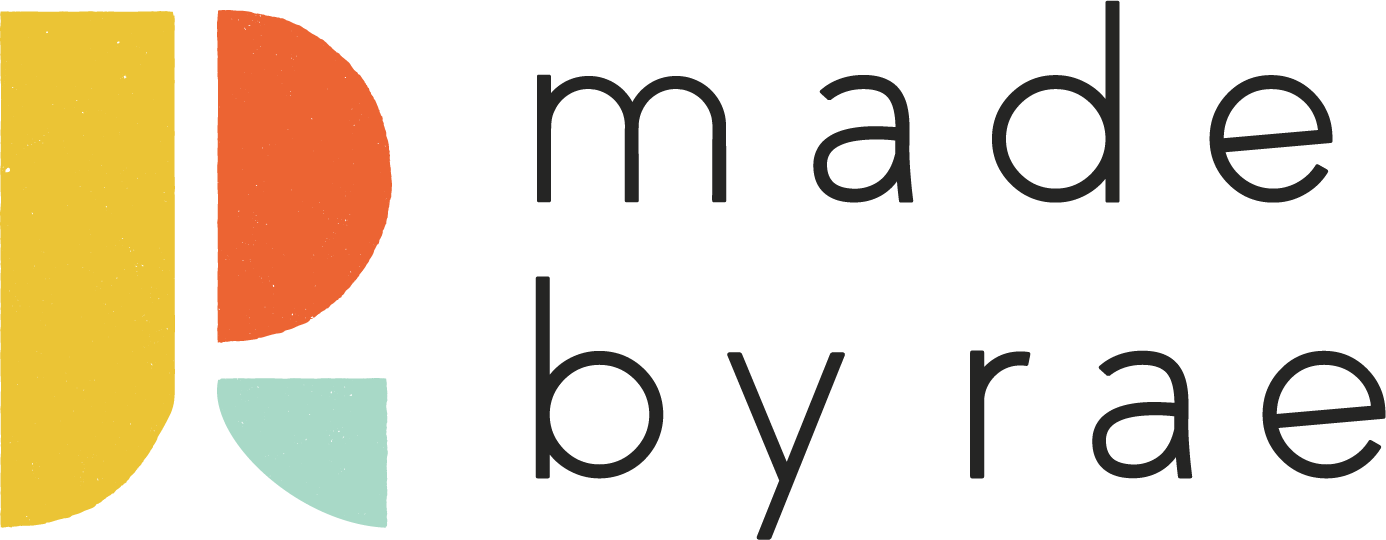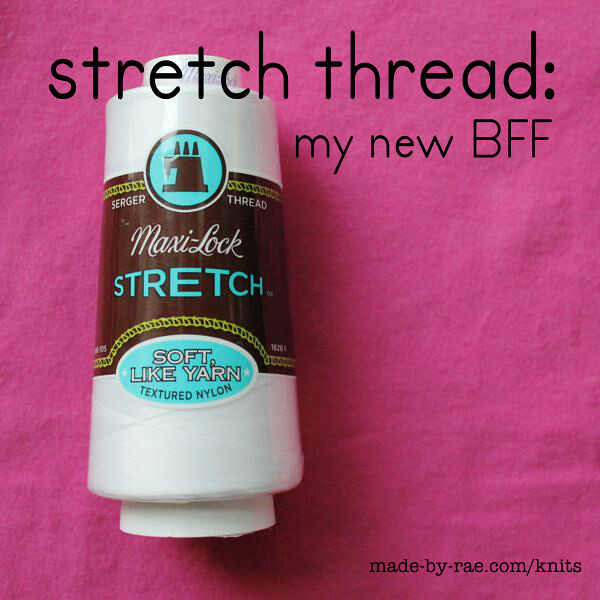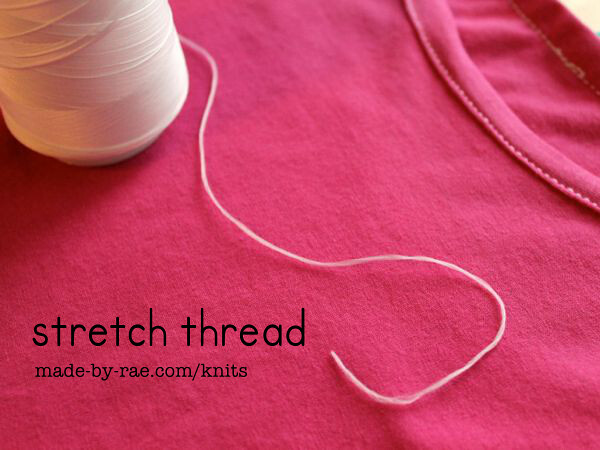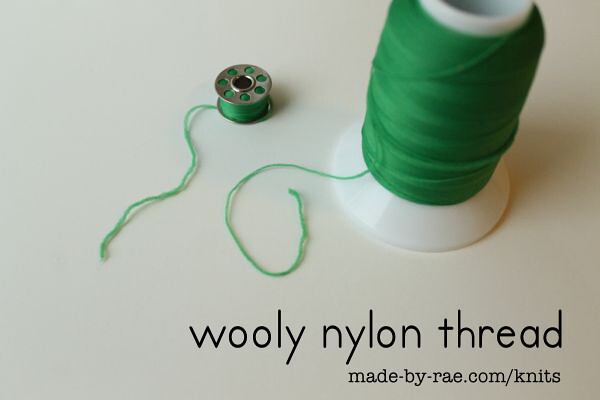Introducing Stretch Thread, my new BFF.
Whenever I do the KNITerviews, I get really geeked about sewing with knits which makes me want to add a few extra posts to help get people started sewing with knits. I throw these posts into a side series called “KNITS: Stretch Yourself” which you can find on my knits page along with the KNITerviews. There’s a few pretty good posts in that series, including a post on hemming, a video on using a walking foot on knits, and a tutorial for a cute knit hat from my friend Shannon, among other things. This year I thought I’d include a few more of these posts again, adding a few new “tricks” that I’ve learned since the last series! Last week I talked about my favorite knit fabrics, and today I want to introduce you to…
Stretch Thread
Stretch thread was mentioned last series by Sascha in her KNITerview, and while I had sewn with wooly nylon thread before (when making this swimsuit for E), I hadn’t ever tried stretch thread. I’ve since discovered that it. is. AWESOME. It allows you to sew a straight seam with your sewing machine without the thread breaking when stretched. I know many people say they don’t have any problem with this, but I have found that I just can’t use a straight stitch with standard polyester thread on knits (even when I use a longer stitch length, or pair it with a double needle, see the hemming post linked above for more info on that); eventually those seams pop out and I have to resew them. Annoying!
For those of you with less experience sewing with knits, let me bring you up to speed: the Big Issue here is that because knit fabrics stretch, the stitches you sew the seams with need to be able to stretch too. In fact, the stretchier the knit fabric you are working with, the more this is true. The usual workarounds include sewing your seams with a narrow zig-zag stitch, which is fine, but in my opinion doesn’t look quite as profesh. Another thing that helps is using polyester thread instead of 100% cotton thread, which has less stretch and tends to break more easily when stretched. A double needle helps because the lower bobbin thread has to go back and forth between the two needles, creating a zig zag on the lower side of the fabric which is more stretchy than a straight stitch. Another option of course is to use a serger, but even sergers have some limitations; for instance, you can’t hem or add knit bindings to necklines with a basic serger. Enter, STRETCH THREAD:
See how it's a bit fuzzy? It behaves a bit like a teeny tiny piece of yarn, so it's got a bit of stretch. Stretch thread is similar to wooly nylon thread, which is another alternative to stretch thread that is even MORE stretchy. Here's wooly nylon, just for contrast:
Maybe you can see that it's even more stretchy? OK let me zoom in:
You can find wooly nylon at your neighborhood craft superstore, but it’s a bit pricey ($10-$15 for 1000 yards), so I prefer to buy stretch thread for the majority of my knit sewing because it’s cheaper ($10 for 2000 yards). By the way, I’ve been buying mine from WAWAK, which is a bulk sewing supply company that now also sells through Amazon as well, so it’s pretty easy to find. Wooly nylon can also be a bit more difficult to sew with because sometimes it’s SO stretchy it gets tangled in my machine, but I’ve found wooly nylon at J0Ann, so that’s nice. Not sure I’ve ever seen stretch thread there. Wooly nylon is also available in tons of colors at threadart.com.
I am a complete STRETCH THREAD CONVERT I tell you!! I use stretch thread for ALL THE KNITS and I’ve gotten some really fantastic, stretchy seams. Here’s couple recent examples:
The bias-bound neckline for this pink Flashback Tee I made for Clementine (I used a ballpoint needle for this knit jersey, along with a slightly longer straight stitch than normal):
And the green stretchy maternity tee that I made for myself a few weeks ago (posted here) was really fun to make and hem, thanks to stretch thread and a double needle!
Things to remember when using stretch thread:
I use stretch thread for both the top and bottom threads; for the bobbin, I wind it just as you would regular thread.
if you have a machine that doesn't work with the large cone of thread that stretch thread comes on (like me), just place the cone on the table behind your machine and thread as usual. The weight of the cone will hold it on the table in place. You can see a picture of this here (there are two cones pictured here because I was using a double needle at the time).
you still need to use a stretch or ballpoint needle on your sewing machine
I recommend using a slightly longer stitch length with stretch thread; in general, the farther the distance between each stitch, the more flexibility your seam will have to stretch, especially over necklines
stretch thread can be a bit harder to thread through the needle because it's more fuzzy, but if you clip the end nice and clean with a sharp scissors and then wet the thread just a bit, it threads quite nicely
make sure to do plenty of stitching back and forth at the beginnings and ends of your seams -- the stretchy nature makes it more likely to pull out at the ends. I would even go so far as to suggest you thread your tails through a needle, pull them to the back side of the fabric, and tie them in a little knot before trimming them.
go slow. Stretch thread is a bit more fussy than regular thread, so start with your needle in the down position before beginning a seam, and stitch slowly so the thread won't tangle.
Alright. Have I convinced you?? This stuff is awesome. Try it!!!
This post is part of the KNITS: Stretch Yourself Series









